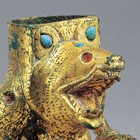J.J. Lally & Co., Oriental Art / New York City, New York
MenuPast Exhibition
Bronze and Gold in Ancient China
March 24 - April 12, 2003
19.
AN INLAID GILT BRONZE BEAR
Han Dynasty (206 B.C.- A.D. 220)
shown crouching and leaning forward with jaws open wide in a snarling attitude, the stylized animal hollow cast with a wide opening at the top of the head to accommodate a wooden shaft, vigorously modelled, with long sharp claws on all four paws and with a wide ruff of fur framing the head, the surface elaborately engraved all over with short wavy lines to suggest fur and with tiered wings or flame motifs filled with small rings curling back from the haunches and shoulders, the straight backbone also engraved with small rings and short, curled wing-motifs above the stubby tail, the eyes deeply inset for inlays now lost, and showing cinnabar red in the recesses, the forehead and raised ears with turquoise inlays, and the arms, legs and belly all with deep circular recesses showing red cinnabar remaining inside, the surface richly gilded overall and the gilding very well preserved, with some small areas of bright green corrosion under the arms and around the feet.
Height 2 5⁄8 inches (6.7 cm)
Compare the smaller gilt bronze bears supporting a hu wine container in the Palace Museum, Beijing inscribed with a Han date corresponding to A.D. 45, illustrated by Weng and Yang in The Palace Museum: Peking; Treasures of the Forbidden City, New York, 1982, p. 143, pl. 76.
Other similar Han gilt bronze bears in various sizes with provision for inlays are published by Brinker, Bronzen aus dem alten China, Zurich, 1975, p. 153, no. 125, in the collection of the Rietberg Museum; by the Victoria and Albert Museum, in the catalogue entitled The Mount Trust Collection of Chinese Art, London, 1970, no. 12; and in Ancient Chinese Arts in The Idemitsu Collection, Tokyo, 1989, no. 256.
